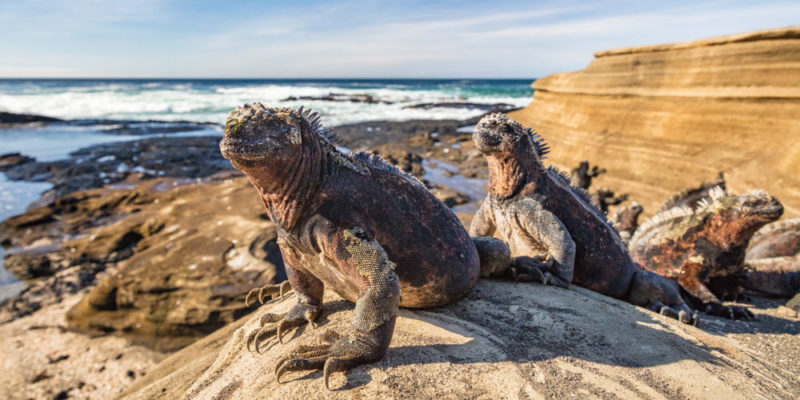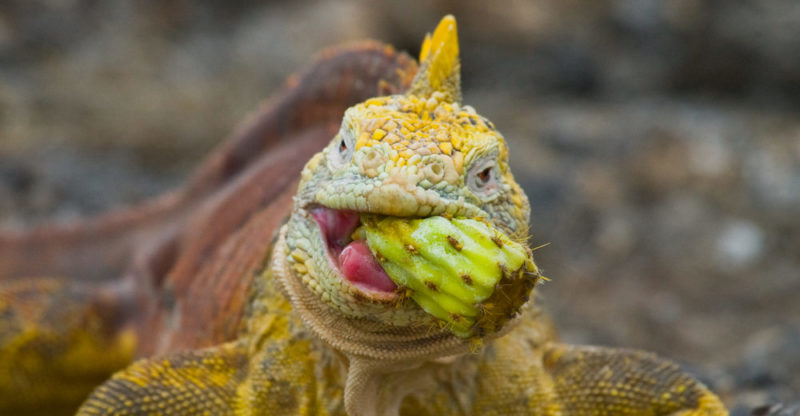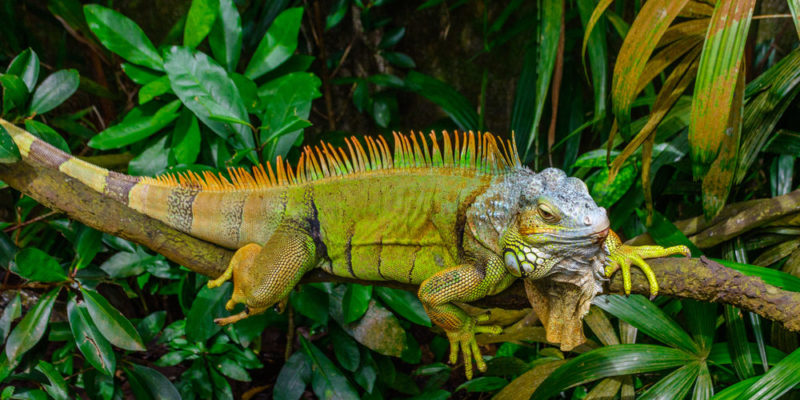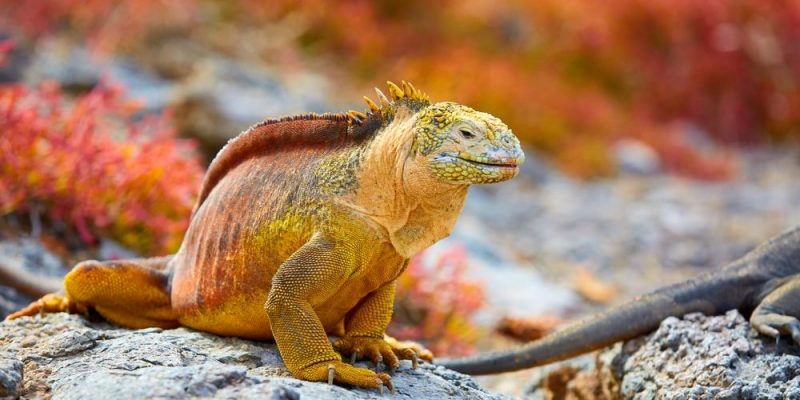We explain everything about iguanas, the types that exist and how they feed. Also, what are its characteristics, reproduction and more.
What is an iguana?
With the name of iguana, a genus of large , scaly reptiles is called, scientifically called the iguaninae family . They are native to the American continent and their presence extends from Mexico to Brazil , including the Caribbean.
It is a group of medium to large-sized lizards, which can be seen basking in the sun high in the trees to warm their cold blood , especially in regions close to water . Its name comes from the word in the Taino language to name the animal: iwana.
This genus encompasses around 30 different species . Their coloration, length and other specific features can vary according to the species, but they all share a similar pattern: four legs, an elongated body on which there is a chain of beaks, behind the neck, called tubercular scales.
The iguana was first described by the Austrian naturalist Joseph Nicolaus Laurenti in his book Specimen Medicum, Exhibens Synopsin Reptilium Emendatam cum Experimentis circa Venena from 1768.
Types of iguanas

Iguanas can be of different types, according to their species and the name that is commonly given to them.
We can speak, thus, of three main types:
- Green Iguana. The most common of all iguanas. It usually lives high up in the trees, and even in Central American and Caribbean cities .
- Desert iguana. A variant adapted to the extreme environmental rigors of the arid climate , such as the desert or the tundra .
- Marine iguana. Also called the Galapagos iguana, since it is common in the islands that bear that name, in Ecuador . They have adapted to coastal life and can swim very well, hold their breath underwater, and even eat marine animals.
Iguana feeding

Commonly, iguanas have a vegetarian diet: leaves, buds, flowers, fruits . These foods are fermented in your stomach, where it harbors bacteria specialized in the decomposition of plant tissue .
However, when iguanas are young they can eat small insects or other invertebrates , small birds , and even mammals .
Habitat of the iguanas

The iguana is essentially arboreal, that is, it lives in trees . It is an excellent climber and usually lives at heights of 1.2m above the ground. They are easy to find in the rainforests of tropical America, in Central America , the Caribbean, South America, and North America .
It should be noted that there are species adapted, equally, to marine , desert climates or to terrestrial life. Each constitutes a different species of iguana.
Functions of your skin

The iguana's skin is made up of scales, as in the case of other lizards , and is dry and tough. Its coloration can range between intense green, brown and darker tones, depending on the specific habitat of the iguana, since it provides a certain degree of camouflage.
Unlike mammals, reptiles are not endowed with internal mechanisms for thermoregulation . For this reason, the skin fulfills an essential function, since it allows it to receive the sun and assimilate its heat.
Iguana senses
Iguanas have extraordinary vision , capable of detecting bodies, shadows and movement at a great distance. For this they use both eyes, unlike chameleons and other species.
Like other amphibian or reptilian species, they possess a rudimentary third eye , known as the parietal eye, which resembles a pale scale in the middle of their head.
His hearing, on the other hand, is more rudimentary . It consists of an eardrum near the eyes that captures sound waves and transmits them to the brain.
How does the iguana reproduce?

Iguanas are oviparous , that is, they reproduce through eggs . The young are incubated there for a period of 90-120 days. When they hatch, totally independent young emerge from the first moment.
The sexual maturity of the iguana is reached between 3 and 4 years, when the males compete with each other for the females. Each one reproduces with as many of them as possible , but instead they will accept a single male per season.
Intercourse lasts between 10 and 45 minutes . However, females can retain the male's sperm for a long additional time, being able to fertilize new subsequent litters with them.
How does the iguana move?
The iguana is an excellent climber. Its four joints are designed for quick movements , allowing it to escape predators and, at the same time, swim if necessary. Its tail is not prehensile, but serves to stabilize the body.
Domestication of the iguana

Many species of iguana are known to serve as domestic pets, although they may be somewhat exotic . Establishing the bond with these animals usually requires a lot of work, patience and perseverance, since their presence in human societies has been, at best, marginal.
In some places it is used as food , but in general it does not have much contact with man . However, there is an opinion that iguanas can even learn the meaning of words and gestures, and act accordingly.
Most common species
The most common species of iguana are:
- Iguana iguana . The most common and ordinary species of iguana, also called "green iguana", which abounds in forests and cities of the American tropics.
- Amblyrhynchus cristatus . Inhabitant of the Galapagos Islands, known as a marine iguana, adapted to sea life and the total absence of trees.
- Colonophus marthae . A physically quite different species, with a pink coloration and terrestrial habits (called, therefore, the land iguana), also inhabits the region of Ecuador near the Galapagos Islands. Their difference from their marine cousins inspired Charles Darwin himself to come up with his theory of speciation.
Conservation status of the iguana

Although the iguana as a species is not threatened, its habitat is under siege by incessant logging and the expansion of cities, which begins to force it to live with humans.
In any case, the iguana does not have large predators , nor is it part of the daily diet of American human societies.
The above content published at Collaborative Research Group is for informational and educational purposes only and has been developed by referring reliable sources and recommendations from experts. We do not have any contact with official entities nor do we intend to replace the information that they emit.
Veronica is a culture reporter at Collaborative Research Group, where she writes about food, fitness, weird stuff on the internet, and, well, just about anything else. She has also covered technology news and has a penchant for smartphone stories. .
Leave a reply
Your email address will not be published. Required fields are marked *Recent post

Sport: What Is It, Types, Risks, Features, Characteristics and Examples

Dogs: Emergence, Features, Characteristics, Feeding and Breeds

Story: Definition, Elements, Structure, Features and Characteristics

